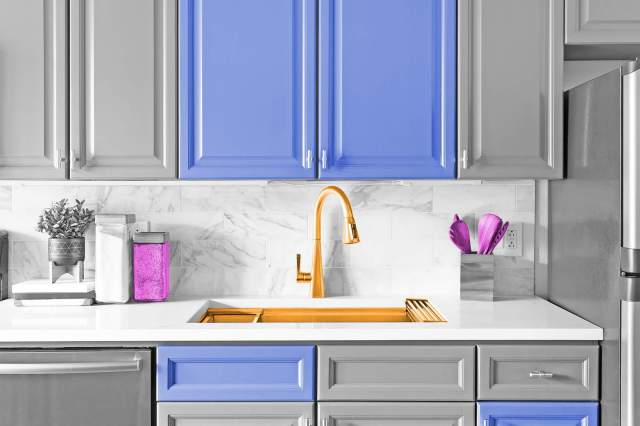
The Modern Apartment Kitchen Was Invented by a Member of the Anti-Nazi Resistance
If you live in an apartment or condo, your kitchen is likely modeled off of a design pioneered by Austrian architect Margarete Schütte-Lihotzky in 1926. Her model kitchen, known as the Frankfurt Kitchen, was invented in response to rising urbanization and the emerging field of domestic science. Schütte-Lihotzky was inspired by the tight quarters of railroads and ships, and created the efficient, small galley kitchen we know today.
Each Frankfurt kitchen had labeled storage bins, easy-to-clean surfaces, built-in accessories like ironing boards and a drawer for garbage, and a swiveling stool so housewives could achieve what Schütte-Lihotzky called “the rationalization of housework.” Designed with busy, independent women in mind, the model kitchen was adopted throughout Europe. Over 10,000 were produced between 1925 and 1930.
Yet Schütte-Lihotzky wasn’t just a kitchen pioneer. She was also an ardent Communist who became a member of the anti-Nazi resistance during World War II. She was arrested and imprisoned by the Gestapo, and barely escaped with her life after Vienna was liberated in 1945. As a Communist, she suffered a lack of commissions in Austria during the Cold War, but worked in China, Cuba, the Soviet Union, the German Democratic Republic, and elsewhere.

Dogs Used to Cook Their Owners’ Food
Before there were modern kitchens, there were open-fire facilities where cooks roasted, braised, and boiled their food. But those cooks weren’t always human: In the 16th century, British breeders actually created a breed of dog designed to turn the wheels of spits in kitchens. Known as Canis vertigus (“dizzy dog” in Latin), the “turnspit dog” ran in a hamster-like contraption that kept meat-roasting spits turning … and turning … and turning.
Short and sturdy, turnspit dogs were often given Sundays off so they could accompany their owners to church. But the hardy dogs couldn’t survive the drop-off in demand that accompanied more modern kitchens, and the breed has since gone extinct.

Microwaves Were Discovered By Accident
The development of radar helped the Allies win World War II — and oddly enough, the technological advances of the war would eventually change kitchens forever. In 1945, American inventor Percy Spencer was fooling around with a British cavity magnetron, a device built to make radar equipment more accurate and powerful, when he realized it could do something else: cook food.
With the help of a bag of popcorn and, some say, a raw egg, Spencer proved that magnetrons could heat and even cook food. First marketed as the Radarange, the microwave oven launched for home use in the 1960s. Today, they’re as ubiquitous as the kitchen sink — all thanks to the Allied push to win the war.
More Interesting Reads

There’s a Reason Your Bananas Don’t Taste Like Banana Flavoring
Have some bananas ripening on your kitchen counter? You may have wondered why they don’t taste anything like the “banana flavor” you find in candy and ice pops. That’s because banana flavor is thought to be based on the Gros Michel banana — not the banana variety most commonly sold today. Also known as Big Mikes, these small bananas were prized for their sweet flavor and reigned supreme on the world banana market. Then, a soil fungus called Panama disease decimated the variety in the 1950s, and farmers turned to Cavendish bananas to fill world demand instead.

This Cooking Icon’s Entire Kitchen Is in the Smithsonian
Culinary guru Julia Child hosted her TV shows, and her foodie friends, inside a roomy, efficient kitchen in her Cambridge, Massachusetts, home. Complete with high countertops to accommodate her 6-foot-3 frame, pegboards for wall storage, and a restaurant stove the chef bought in the 1950s, the kitchen was packed with cookbooks, appliances, and Child’s iconic pots and pans.
Though the chef died in 2004, her kitchen lives on at the Smithsonian Institution’s National Museum of American History in Washington, D.C. Child donated it to the museum in the early 2000s, and museum workers painstakingly documented it down to the items in each cabinet, then moved the entire thing to the museum and reassembled it there.
According to the Smithsonian, the kitchen — still on display on the museum’s ground floor — was arranged exactly as Child had it when she donated it. “Only the walls and floor were fabricated by the museum and the bananas and tomatoes are replicas,” the museum writes. “Everything else was Julia’s.”

This Could Be the Most Dangerous Item in Your Kitchen
If you’re like most home cooks, you’re cautious with home appliances and open flames. But there’s reason to fear an unexpected item in your kitchen: the avocado. The pitted fruit is a must-buy for anyone who loves guacamole or avocado toast, but it presents a clear and present danger for many home cooks.
One 2020 study describes an “epidemic” of hand injuries due to attempts to cut the green guys, citing an estimated 50,413 avocado-related injuries between 1998 and 2017. Women between 23 and 39 years of age were most at risk, with the majority of avocado-related ER visits occurring on Sundays between April and July. So be forewarned — and treat the delicious delicacies with the respect they deserve.











